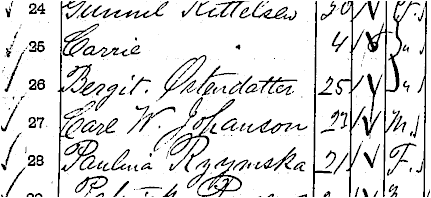I read the handwriting as "Inaburg _t_ndatter" where underscores represent letters I can not make out.
To read the excerpt/image, I used a magnifying glass.
On a separate sheet of paper, I made a record of the letters I could make out. I did this several times, including that one or more times, I started with what seemed the last letter in each name and worked to the first letter.
Edited: I previously had written, "I read the handwriting as Inaburg _t_ndatter; I should have appended that information to include the caption, "[where underscores represent the letters I did not decipher]."
Additional information: Luke wrote, "Now what?"
Source and information are subject to error--add (or include) the further limitation/ability to correctly decipher, interpret and apply the information correctly in historical context.
Use care in working with each document and work with and come to rely upon a variety of source materials to develop a body of evidence. Know that all this is changeable over time as yet new evidence is discovered or existing evidence is better understood/interpreted. The work over time requires keeping evidence, information and sources in context.
Make a record of the source so that you will always be able to interpret the information in the context of the source. Records and record groups have their own history and story to tell, so this process usually represents something more that the record of a book and page number or URL. The process of making the record of the source often involves consulting material other than the record itself. You may have to locate and review a record group description even the history and customs of a place, people or event type.
Record the information and fully develop your citation. In this case, there are several levels of reason and logic that apply. Because Luke wrote, "I don't know for sure if this is the record I'm looking for or not," he has introduced the concept of certainty about the decipher. As well, Luke no doubt has access to a more complete set of materials--only he knows the context in which he can or would use the information from this source—thus there is the more important concept of certainty in a genealogical sense.
Luke has the option of deciding whether his confidence is such that he has a degree of certainty in this record of if the information only warrants a research note.
If he has a degree of confidence in the record, then he can let his "Ps" shine with skillful application of words like possibly, perhaps and probably.
- Patricia Law Hatcher wrote, "The process of expressing our findings in our writing—including proper use of terms such as probably, possibly, likely, and maybe—is the most valuable tool we have in our research kits. Unfortunately, it is also the most neglected."[1]
- In a January 2008 editorial, Henry B. Hoff wrote, "With all genealogical articles, the specter of the 'P-words' (possibly, perhaps, probably) hovers overhead. When can we say a connection or identification is definite? When do we have to use one of the 'P-words'? And if so, which word?" Hoff goes on to suggest that one of the best ways to learn how to apply the "Ps" is to read genealogical articles that are published in scholarly journals.
- In her work, Evidence Explained, Mills provides her insight and description about five levels of confidence. She provides a range--decreasing in level of confidence as certainly, probably, possibly, likely and apparently—and she describes each level. [3]
[1] Henry B. Hoff CG, FASG, Editorial, The New England Historical and Genealogical Register 162 (January 2008): 3.
[2] Michael Leclerc and Henry Hoff, editors, Genealogical Writing in the 21st Century: A Guide to Register Style and More, 2nd ed. (Boston, Mass.: New England Historic Genealogical Society, 2006), p 1.
[3] Elizabeth Shown Mills, Evidence Explained: Citing History Sources from Artifacts to Cyberspace, electronic ed. (Baltimore: Genealogical Publishing Co., 2007), p. 19.

